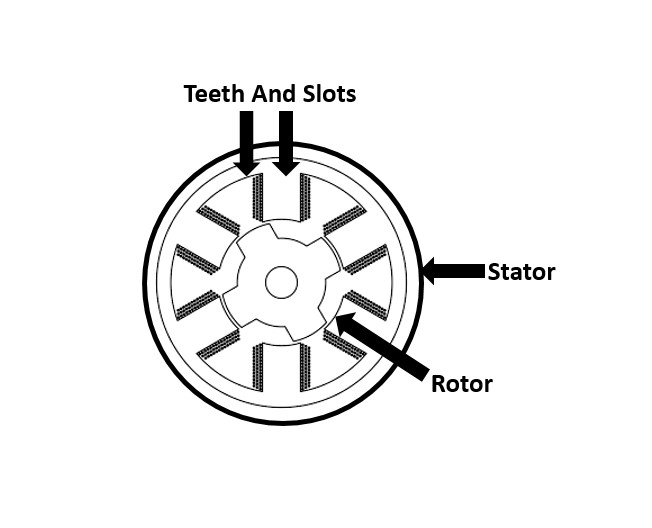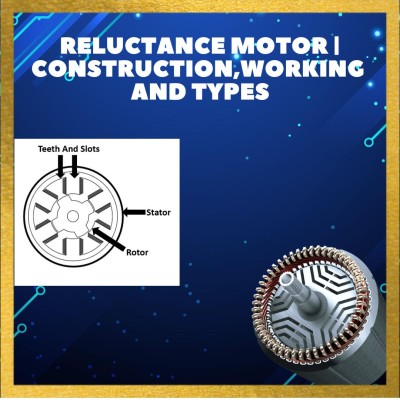What is Reluctance Motor?
A reluctance motor is a type of electric motor that transforms electrical energy into mechanical energy by employing the magnetic reluctance principle. The motor generates a force that causes the rotor to rotate by using a rotor (the moving portion of the motor) that has a lower reluctance than the stator (the stationary element of the motor). The rotor and stator are often constructed from laminated iron or other magnetic materials, and the rotor is frequently configured to have a number of “poles” or “teeth” that can interact with the magnetic field of the stator. Reluctance motors are frequently employed in applications like pumps, fans, and conveyors where simplicity and cost are crucial considerations.
Construction Of Reluctance Motor
A laminated iron rotor and a stator, both of which are magnetic materials, are commonly used in the building of reluctance motors.
The revolving component of the motor is the rotor, commonly referred to as the rotor core. It frequently has a cylinder shape with several teeth or poles. These poles are constructed of mild iron and are not magnetised.
The stator, which encloses the rotor, is the motor’s stationary component. The stator winding is normally carried by a stack of laminated iron sheets. The rotor is affected by the magnetic field produced by the stator winding, which is coupled to the power source.

A revolving magnetic field is produced around the stator when the stator winding is energised with alternating current, allowing it to function as a motor. The magnetic field of the stator is aligned with the poles of the rotor, which induces a rotational force.
The motor may also feature a cooling mechanism to disperse heat produced during operation and a bearing system to maintain the rotor.
In conclusion, a reluctance motor is made up of a stator made of laminated iron sheets holding stator winding and a rotor made of soft iron with many teeth or poles. When the stator is energized, this provides a rotating magnetic field that causes the rotor to rotate.
Working Of Reluctance Motor
The working of a reluctance motor can be explained through the following steps:
- A revolving magnetic field is produced around the stator as a result of alternating current energising the stator winding.
- The rotor encounters a force that makes it revolve as soon as its poles line up with the magnetic field of the stator.
- The rotor’s poles’ location in relation to the magnetic field of the stator shifts when it begins to rotate. As a result, the magnetic circuit’s reluctance changes, which in turn causes the rotor to feel a force that is proportionate to the reluctance’s rate of change. The rotor is propelled to rotate even further by this force.
- The rotor’s shape is intended to maximise the force felt by the rotor and induce it to rotate at a greater speed by minimising the magnetic circuit’s reluctance when it aligns with the magnetic field of the stator.
- As the rotor rotates, the stator’s magnetic field also rotates and so does the rotor. The rotor’s poles move away from the stator’s magnetic field, and the reluctance of the magnetic circuit increases. As the reluctance increases, the force experienced by the rotor decreases and the rotor slows down.
- The rotor rotates in time with the stator’s magnetic field as a result of this operation, which is repeated when the stator’s magnetic field rotates. The number of rotor poles and the alternating current frequency of the stator both affect how fast the rotor spins.
In conclusion, a reluctance motor relies on the interaction of the spinning magnetic field of the stator and the geometry of the rotor to generate torque and force the rotor to rotate. The magnetic circuit’s reluctance is reduced by the rotor’s form to increase rotational speed when it aligns with the magnetic field of the stator.
Types Of Reluctance Motors
There are several types of reluctance motors, including:
- Variable Reluctance Stepper Motor: A rotor with several teeth or poles and a stator with a single winding are used in this kind of reluctance motor. Different configurations of stator windings are activated to change the position of the rotor. These motors are frequently employed in situations where exact placement is necessary.
- Hybrid Stepper Motor: Permanent magnets and a stator winding are used in this kind of reluctance motor to produce a holding torque. This makes it helpful in applications where the load must be retained in a precise place and enables the motor to maintain its position even when power is interrupted.
- Synchronous Reluctance Motor: A rotor with many teeth or poles and a stator with several windings are used in this kind of reluctance motor. Different configurations of stator windings are activated to change the position of the rotor. These motors are frequently employed in applications that need high power-to-weight ratios and efficiency.
- Permanent Magnet Reluctance Motor: This type of reluctance motor uses a rotor with a large number of teeth or poles and a stator with a single winding. The rotor’s position is controlled by energizing different combinations of stator windings. These motors are typically used in applications where high efficiency and high power-to-weight ratio are required.
- Linear Reluctance Motor: The operation of this kind of reluctance motor is similar to that of a conventional reluctance motor, however it is linear rather than rotational. Typical uses for these motors include conveyors, linear actuators, and other linear motion systems.
Each of these types of reluctance motors may have its own characteristics and advantages that make them suitable for different applications.
Advantages Of Reluctance Motor
Advantages of Reluctance Motors:
- Simplicity: Reluctance motors are relatively simple in design and construction, which makes them less expensive to manufacture and maintain.
- High efficiency: Reluctance motors have a high efficiency level, which means they convert a large portion of the electrical energy they consume into mechanical energy.
- High Power-to-Weight Ratio: The rotor in a reluctance motor is typically made of laminated iron, which is lightweight and can be made with a large number of poles. This results in a high power-to-weight ratio, making them suitable for applications where weight is a concern.
- High Torque at Low Speeds: Reluctance motors can generate high torque at low speeds, which makes them suitable for applications that require a high starting torque such as compressors, pumps and conveyors.
- Low Noise: Reluctance motors tend to produce less noise than other types of motors, which makes them suitable for applications where noise is a concern.
Disadvantages Of Reluctance Motor
Disadvantages of Reluctance Motors:
- Limited Speed Range: Reluctance motors are less suited for applications that call for high-speed operation because of their constrained speed range.
- Limited Starting Torque: When compared to other types of motors, reluctance motors may have a lower beginning torque, which makes them less appropriate for applications requiring a high starting torque.
- Limited Position Control: Reluctance motors are less effective for applications that call for precision positioning since the rotor position is not directly controlled.
- Limited Power Density: Reluctance motors are less suitable for applications that call for a high power-to-weight ratio since they have a lower power density than other types of motors.
- Limited Overload Capacity: Reluctance motors are less suitable for applications that call for a large overload capacity because of their restricted overload capacity.
Applications Of Reluctance Motors
Reluctance motors have a wide range of applications due to their simplicity, high efficiency and high power-to-weight ratio. Some common applications of reluctance motors include:
- Industrial Applications: Reluctance motors are frequently employed in industrial settings where high efficiency, low noise, and strong torque at low speeds are necessary, such as in pumps, fans, conveyors, and compressors.
- Automotive Applications: Reluctance motors are used in automotive applications such as electric power steering systems and hybrid electric vehicles, where high efficiency and high power-to-weight ratio are important.
- Home Appliances: Reluctance motors are used in household appliances like refrigerators, air conditioners, and washing machines because they offer great performance, minimal noise, and high torque at low speeds.
- Robotics: Reluctance motors are used in robotics applications such as robotic arms, where high precision and high torque are required.
- Medical Equipment: In medical equipment like blood pumps where great efficiency, high torque at low speeds, and minimal noise are essential, reluctance motors are used.
- Power Generation: Reluctance motors are used as generators in renewable energy systems such as wind turbines, where high efficiency, high torque at low speeds, and high power-to-weight ratio are required.
- Aerospace: Reluctance motors are used in aerospace applications such as aircraft, where high efficiency, high power-to-weight ratio and high torque at low speeds are required.
- Linear Actuators: When linear motion is required, high efficiency, high torque at low speeds, and high power-to-weight ratio are required, linear reluctance motors are utilised for linear actuators.
View More Post:
Raspberry Pi 3 Pinout Demystified: Everything You Need to Know
Raspberry Pi 4 Pinout Demystified: Everything You Need to Know

